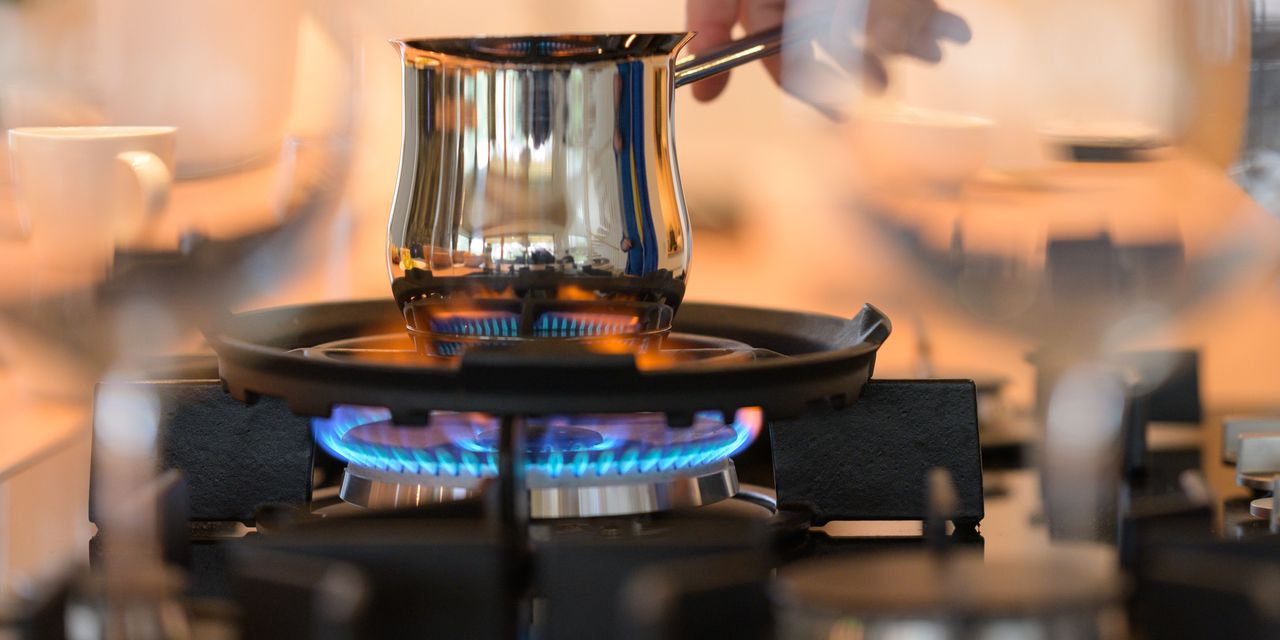The natural gas that lights popular gas stoves for both home and professional cooks contains low concentrations of several pollutants and chemicals linked to cancer, a new study has found.
The study, by the Harvard T.H. Chan School of Public Health and published this week in the journal Environmental Science & Technology, is the latest in a growing body of research that links both the delivery and use of natural gas
NG00,
to possible consequences for public health and climate change.
An earlier study, from Stanford University, suggested the emissions from gas stoves in U.S. homes have the same climate-warming impact as that of half a million gasoline-powered cars
RB00,
That includes the shorter-lasting but more-potent methane, in addition to carbon dioxide. Fossil-fuel combustion for energy accounts for about 74% of total Earth-warming U.S. greenhouse-gas emissions, the Energy Information Agency says.
Such findings may fuel what has been a slow shift among some cities and states to ban new natural-gas hookups in house and apartment construction. Most older stoves are grandfathered in.
The impact is significant: over one-third of U.S. households — more than 40 million homes — cook with gas.
“Gas stoves leak dangerous methane into our homes — even when the stoves aren’t on,” says Donnel Baird, CEO and co-founder of BlocPower, a climate technology company that mostly addresses electric retrofits and adds solar to buildings.
Unlike other gas appliances, such as water heaters that are usually placed away from active living spaces, cooking appliances directly expose people to their emissions. These emissions include formaldehyde, carbon monoxide and nitric oxides that can trigger asthma, coughing, wheezing and difficulty breathing.
Related: The bitter breakup with gas stoves is getting closer — here’s another reason why
And now the Harvard study has uncovered more emissions, looking at the smaller traces of chemicals.
Over 16 months, researchers collected 234 samples of unburned natural gas from 69 homes in the Boston metropolitan area that received natural gas from three suppliers. They turned up several “air toxics,” which is an Environmental Protection Agency classification of hazardous pollutants, including benzene.
“Twenty-one of those [air toxics] are sufficiently harmful to human health that they’re considered hazardous air pollutants to the EPA,” Dr. Curtis Nordgaard, a participant in the Harvard study told Boston’s CBS affiliate WBZ-TV. “Benzene is a known carcinogen. It causes leukemia,” he said.
Short-term exposure to high levels of colorless and odorless benzene could lead to drowsiness, dizziness, headaches and eye and skin irritation, according to the Centers for Disease Control and Prevention. Longer-term exposure means that small effects can add up, boosting the risk of blood disorders and certain cancers, the CDC says.
Too tiny to matter?
Pipeline operators and natural gas suppliers generally test the composition of gas along the production process, including at power plants, in accordance with the North American Energy Standards Board. But to date, those tests are limited to roughly 16 of the most abundant components of natural gas. It excludes, for instance, benzene, the study authors stressed.
The Harvard team said their emphasis was on detecting more of the potentially hazardous makeup of gas at the point of greatest human exposure. More study on the public health impacts is needed, they added.
Some public health officials were also quick to point out that it’s not clear if small traces of these chemicals alone are particularly dangerous, especially with ventilation. Benzene is already found in plastics, resins and other materials.
In American kitchens, hood use and ventilation help reduce concentrations pollutants in the air, yet surveys show that home cooks on average use them only 25% to 40% of the time, the earlier Stanford research showed. The highest emitters were cooktops that ignited using a pilot light instead of a built-in electronic sparker.
Cities take action
New York City has created a law that prohibits the combustion of fossil fuels, namely gas, for cooking and heating in select new buildings. The ban will apply to new structures under seven stories tall starting in 2024, and to larger buildings in 2027. That measure is significant not only because of the city’s population size, but also because of its colder climate. The state was considering its own bill, but the effort died in budget talks this spring.
New York is not alone. Berkeley, Calif., became the first city in the U.S. to ban gas hookups in new construction in 2019. And now at least 42 cities in California, including San Francisco and San Jose, have acted to limit gas in new buildings. Salt Lake City and Denver have also made plans to move toward electrification. And notably, Ithaca, N.Y., took the step to convert all of its buildings, not just new construction, to heat pumps and electric ranges over gas. Meanwhile, some 20 mostly Republican-led states have passed laws barring cities and counties from blocking gas hookups.
Proponents of keeping fossil fuels in a U.S. energy mix, even those who also want renewables to take a larger share, have said a too-quick jump in electric power use will strain a U.S. electricity grid that already reveals weaknesses. They stress that natural gas has been a low-cost alternative to dirtier coal and could play a role in the energy transition.
The gas industry believes home bans don’t target the right problem, and instead focus should be on developing renewable natural gas.
A household focus “is not really a climate solution,” said Daniel Lapato, senior director of state affairs with the American Gas Association, an advocacy group for the natural-gas industry, talking to the nonprofit Pew. “When you start eliminating these options, you have to look at the cost implications to the homeowner.”
